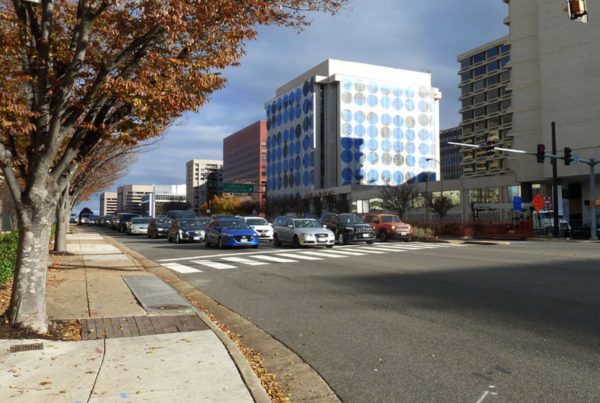
The state’s idea to lower elevated segments of Route 1 through Crystal City could cause more injuries to pedestrians and chronic congestion, according to a new report.
This summer, the Virginia Department of Transportation officially decided to turn Route 1, which is elevated over 12th, 15th and 18th Streets S., into an at-grade urban boulevard. It would feature wide buffered sidewalks on both sides, six to seven narrowed travel lanes, a 30-mph speed limit, wide crosswalks, landscaping and medians with pedestrian refuges.
The changes, which could cost $180 million, are aimed at making the corridor more pedestrian-friendly, but that may not actually be the case, according to the VDOT-commissioned report. Using Arlington County rush hour traffic forecasts, the report predicts pedestrian-involved crashes could increase.
Meanwhile, travel times could lengthen by up to 6 minutes for vehicles heading into Crystal City in the morning and heading out in the afternoon, due largely to delays for drivers turning left on Route 1 and several commuter bus stops getting rerouted.
Arlington County staff questioned how these negatives could square with VDOT’s preference for the concept, per a staff report. They suggested that the authors make the negative results of the traffic analysis clearer.
“An at-grade Route 1 has many operational challenges,” county staff said. “The short block lengths between parallel streets result in the need to coordinate signals and thus, the pedestrian delays will be increased on the minor parallel routes. The results point to negative impacts on the ability of transit to effectively serve the National Landing area. The at-grade scenario shown in the preferred alternative offers a more limited network connectivity while simultaneously introducing conflicts and sacrificing transit mobility.”
The report, prepared by engineering consulting firm Kimley-Horn, specifically recommends one at-grade option that allows all turns at 15th Street S., eliminates left turns at 18th Street S., and possibly includes a pedestrian underpass or overpass at 18th Street.
The state initially agreed to the study and changes to Route 1 as part of its 2018 agreement with Amazon to invest in transportation in the region.
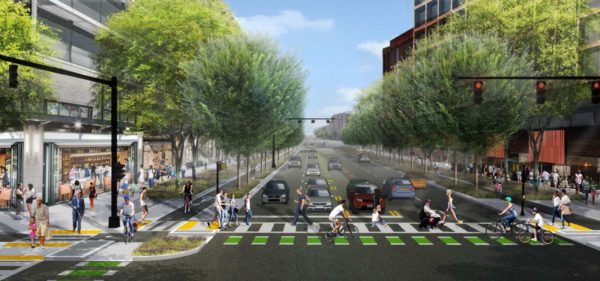
Pedestrian safety
As progress ramped up on the study, locals and organizations following the Route 1 project have kept pedestrian safety front and center.
When VDOT initially considered a nine-lane highway, advocates said that would be unsafe for pedestrians and the National Landing Business Improvement District (BID) created its own renderings for a tree-lined and pedestrian-friendly Route 1.
After VDOT revised its proposal and announced its intention to bring Route 1 at-grade, Livability 22202 — a coalition of three area civic associations — rejected the study for several reasons, chief among them that even the new six- to seven-lane highway would not, in their view, improve pedestrian safety.
Data in the report appears to bear that conclusion out. Over two decades, pedestrian traffic during peak afternoon hours could increase 2x to 5x current levels, and with that could come more crashes involving pedestrians.
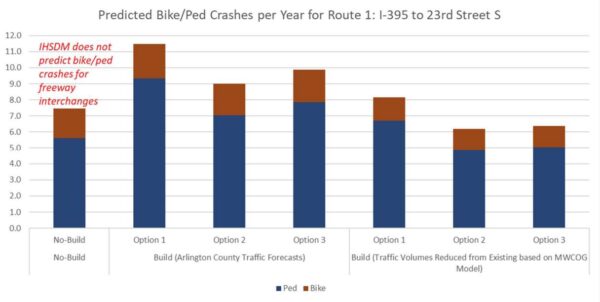
The report says it’s likely that travel patterns will change with an at-grade boulevard, as “some trips may divert to alternate routes, other trips may divert to alternate modes given the multimodal accommodations in the study area.”
Assuming reduced traffic volumes, the report says the number of bicycle and pedestrian crashes for VDOT’s preferred at-grade option will be slightly lower than if nothing were to be rebuilt because left turns will be eliminated at the 18th Street S. intersection. It also notes that between 2015 and 2019, no bicycle or pedestrian crashes were observed at the 15th Street S. intersections.
One way the report proposes facilitating safer pedestrian crossings is with a bridge over 18th Street S. That doesn’t sit well with members of the People Before Cars coalition, a group that transportation advocates, the National Landing Business Improvement District and developer JBG Smith launched by the BID this summer.
“Highway overpasses and pedestrian bridges are not pedestrian safety infrastructure — they are automotive infrastructure designed to speed cars along by allowing them to avoid waiting for pedestrians to safely cross the street,” coalition member and Transportation Commission Chair Chris Slatt said. “We built a maze of pedestrian bridges in Rosslyn in the 70s and 80s in the name of safety and now we’re tearing them all out because it’s a failed approach. Pedestrians largely don’t enjoy using them, they increase danger for those pedestrians who do cross at-grade because there are fewer pedestrians doing so, and they strangle street-level activity.”
He predicted that the bridge will force pedestrians to cross at 15th Street S., where they will interact with the increased traffic on neighborhood streets like S. Eads Street and 15th Street S.
Longer travel times
The Kimley-Horn report found that vehicle travel times would increase somewhere between 90 seconds and 6 minutes, depending on the at-grade configuration.
Predicted travel times increases are greatest for VDOT’s preferred option — all turns allowed at 15th Street S. but no left turns at 18th Street S., or “Option 3,” according to a chart from the report.
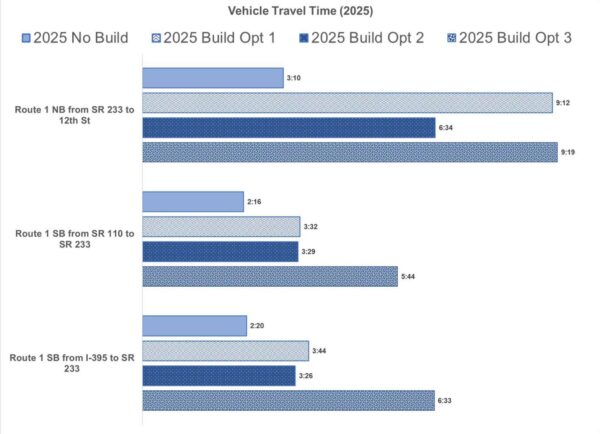
The report also found that the at-grade build options would displace bus stops along 18th Street S. for three commuter buses connecting Arlington to Loudoun and Fairfax counties.
On social media, even those normally supportive of putting pedestrian and transit infrastructure over the needs of drivers were skeptical of the benefits of the changes in relation to the costs of doing so, suggesting that more could be done with less.
All kinds of little brown nuggets lurking in the final report. You're actually going to pay nine figures to do this!!! https://t.co/bNktWJnxrW pic.twitter.com/FgaKOFiQez
— Car-Free HQ2 (@CarFreeHQ2) November 9, 2021
Again, your tax dollars are going to *pay* nine figures to do this!
— Car-Free HQ2 (@CarFreeHQ2) November 9, 2021
The report suggests that the negative impacts can be mitigated, however.
The potential for a significant increase in travel time for bus riders, for instance, will be mitigated by a proposed bus transfer facility between Route 1 and S. Bell Street, which is included in a 2010 sector plan guiding development in Crystal City, the report says.
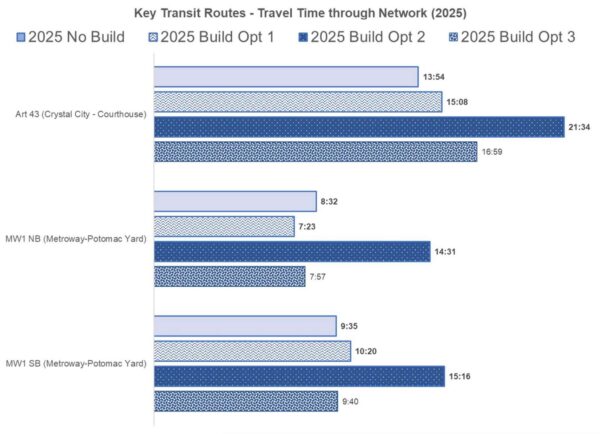
But that bus facility is not set in stone, and VDOT needs to explore other options for displaced bus routes, county staff say.
“Overall, significant additional study is needed of all aspects related to the intermodal center,” staff said. “If intermodal transit center is not feasible, what will be the solution for the commuter bus stops along 18th Street (serving Fairfax Connector, Omniride, and Loudoun Transit) that are displaced?”
Taken together, staff say the negative outcomes of an at-grade Route 1 could outweigh the savings VDOT says it achieves by not taking parts of Route 1 below-grade, which has also been suggested as a potential alternative, albeit a costly one. This idea is included in the 2010 sector plan for Crystal City and was championed by civic group Livability 22202.
The at-grade concept would cost about $180 million, compared to the below-grade concept, which could $280 million. Eschewing major changes and just making some low-cost improvements instead would cost between $5 and $15 million.
The report has county staff wondering how much VDOT will delegate the responsibility of public safety on the state-managed roadway to the county.
“Given that in the report it is acknowledged that the at-grade concepts generally lower speeds, increase congestion, and increase predicted collisions — shouldn’t the operational costs also be monetized and compared?” staff ask.
“The report says in multiple locations and on this page that there will be reduced [level of service] at the intersections and increased pedestrian and bicycle crashes unless there is a robust [transportation demand management] strategy that is employed,” staff add. “This seems to shift responsibility to the County to implement.”
Now that the first phase of study is done, VDOT will be embarking on a second phase of study, which will examine the feasibility of a pedestrian overpass or underpass, along with methods to lower traffic volumes and mitigate congestion and traffic diversion onto other roads.

